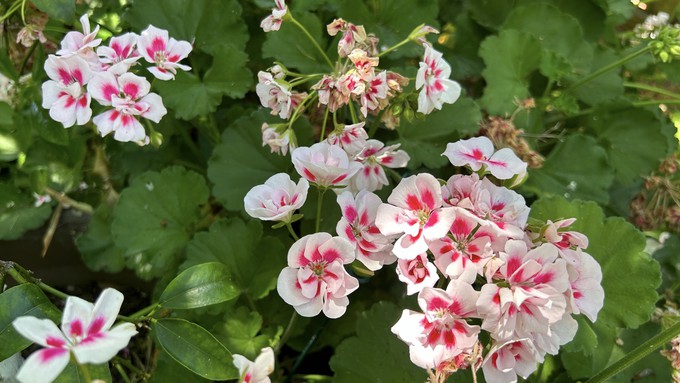
Rain totals add up to something rare for area

The "normal" rainfall we had this year was well-timed, producing abundant blooms on many plants this spring, including this pink and white pelargonium (often called geranium). Kathy Morrison
How would you describe Sacramento’s “water year” so far? According to the rain totals, we had a very wet winter; the rest of the time, not so much. In other words, our rain picture is finally “normal.”
Memorial Day weekend is the unofficial start of summer, which makes this a good time to catch up on our water picture.
The good news? Sacramento (and Northern California overall) had enough big storms this winter to refill reservoirs and boost our overall soil moisture. On May 22, Folsom Lake – the main reservoir serving the greater Sacramento area – was at 95% of capacity and 120% of its historical average on that date.
As gardeners, we saw the results in our landscapes this spring, with abundant blooms and heavy fruit set on trees.
After an above-average April and thunderstorms in early May, Sacramento has totaled 17.60 inches for the current water year, which started Oct. 1. Average for that period: 17.60 inches.
So, according to the National Weather Service, our current water picture couldn’t be more normal. And after recent prolonged droughts, normal feels just right.
How normal are our rain totals right now? Take the current month of May as an example. In Sacramento, its rain total – 0.57 inches – all fell on one day (May 4). Historically, the entire month of May in Sacramento averages 0.57 inches, says the weather service.
There’s little to no chance we’ll see any more precipitation this month, says the weather service, which estimates the probability of rain at “0%” through May 31.
While temperatures will dip into the 70s leading into the long Memorial Day weekend, seasonal heat is coming soon, adds the weather service. A high of 87 is forecast for Monday, Memorial Day, followed by several days in the low 90s (or close to it).
Summer really is right around the corner.
For more on Sacramento weather: https://www.weather.gov/sto/#.
Comments
0 comments have been posted.Sacramento Digs Gardening to your inbox.
Food in My Back Yard Series
May 6: Maintain soil moisture with mulch for garden success
April 29: What's (already) wrong with my tomato plants?
April 22: Should you stock up on fertilizer? (Yes!)
April 15: Grow culinary herbs in containers
April 8: When to plant summer vegetables
April 1: Don't be fooled by these garden myths
March 25: Fertilizer tips: How to 'feed' your vegetables for healthy growth
March 18: Time to give vegetable seedlings some more space
March 11: Ways to win the fight against weeds
March 4: Potatoes from the garden
Feb. 25: Plant a fruit tree now -- for later
Feb. 18: How to squeeze more food into less space
Feb. 11: When to plant? Consider staggering your transplants
Feb. 4: Starting in seed starting
Sites We Like
Garden Checklist for week of May 11
Make the most of the lower temperatures early in the week. We’ll be back in the 80s by Thursday.
* Plant, plant, plant! It’s prime planting season in the Sacramento area. Time to set out those tomato transplants along with peppers and eggplants. Pinch off any flowers on new transplants to make them concentrate on establishing roots instead of setting premature fruit.
* Direct-seed melons, cucumbers, summer squash, corn, radishes, pumpkins and annual herbs such as basil.
* Harvest cabbage, lettuce, peas and green onions.
* In the flower garden, direct-seed sunflowers, cosmos, salvia, zinnias, marigolds, celosia and asters. (You also can transplant seedlings for many of the same flowers.)
* Plant dahlia tubers.
* Transplant petunias, marigolds and perennial flowers such as astilbe, columbine, coneflowers, coreopsis, dahlias, rudbeckia and verbena.
* Keep an eye out for slugs, snails, earwigs and aphids that want to dine on tender new growth.
* Feed summer bloomers with a balanced fertilizer.
* For continued bloom, cut off spent flowers on roses as well as other flowering plants.
* Add mulch to the garden to maintain moisture. Mulch also cuts down on weeds. But don’t let it mound around the stems or trunks of trees or shrubs. Leave about a 6-inch-to-1-foot circle to avoid crown rot or other problems.
* Remember to weed! Pull those nasties before they set seed.
* Water early in the day and keep seedlings evenly moist.